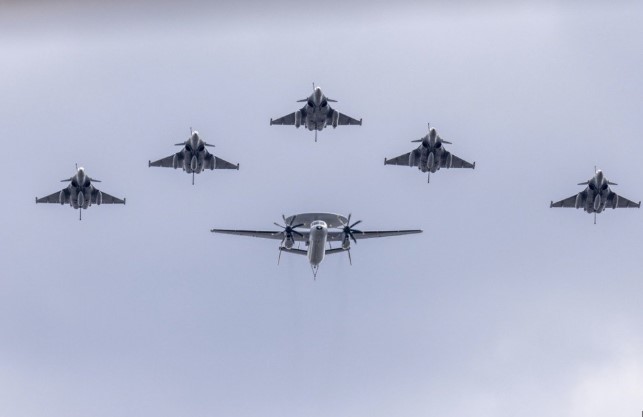Ukraine has announced a massive new defense project aimed at creating a powerful air shield for the country. This large-scale plan focuses on building a modern combat aircraft fleet that will eventually include around 250 new-generation fighter jets. The aircraft lineup will feature American F-16s, Swedish Gripens, and French Rafales — three of the world’s most advanced fighter platforms.
Ukraine’s Ambitious Plan for a New Air Fleet
This project represents one of the biggest steps in Ukraine’s military modernization since the beginning of its security challenges. The plan is designed to restore the country’s air force strength and ensure long-term protection of its skies. According to official information, Ukraine is holding direct negotiations with the United States, Sweden, and France to secure these aircraft.
The focus of this initiative is not only to boost national defense but also to integrate Ukraine’s defense industry with Western aerospace technology and standards. Each of the selected aircraft models offers unique capabilities, and together they form a balanced and versatile air defense system suitable for different missions — from air superiority to ground attack and reconnaissance.
Brussels meetings focus on financing and equipping Ukraine defense forces
Formation of the 250-Aircraft Fleet
Ukraine has chosen three main fighter platforms for its upcoming fleet — the F-16 Fighting Falcon, Saab JAS 39 Gripen, and Dassault Rafale — based on their performance, cost-efficiency, and compatibility with its existing military systems.
- F-16 Fighting Falcon: This American-made jet is already used by many NATO countries and is known for its reliability, maneuverability, and powerful radar systems. It is also capable of carrying a wide range of precision weapons.
- Saab JAS 39 Gripen: The Swedish Gripen is considered one of the most cost-effective multirole fighters in the world. It can operate from short or improvised runways, such as highways, and is easy to maintain.
- Dassault Rafale: The French Rafale uses twin engines and features advanced avionics, strong defense systems, and the ability to perform multiple combat roles simultaneously.
Ukraine’s defense strengthened by Trump’s daring fund backed by Chinese import levies
Ukraine is negotiating with the United States, Sweden, and France to build a fleet of 250 modern fighter jets, replacing its old Soviet-era aircraft.
A major focus is on Sweden’s Gripen jets, known for easy maintenance, short pilot training of about six months, and compatibility with Ukraine’s existing weapons.
Under preliminary agreements, Ukraine will receive 150 Gripens, with plans to assemble parts locally in Ukraine. This step marks a historic boost for the nation’s aviation industry through technology transfer and industrial growth.
Strategic Importance and International Cooperation
Ukraine’s decision to pursue these three advanced aircraft types demonstrates a strategic effort to build long-term air defense independence. The plan highlights a shift toward full compatibility with Western defense systems, allowing smoother coordination with partner nations in joint defense efforts.
The Swedish company Saab, which manufactures the Gripen, has already announced its readiness to open a final assembly plant in Ukraine as part of the cooperation. This move would help speed up the delivery of aircraft while creating new skilled jobs in Ukraine’s defense industry.
Meanwhile, France has confirmed additional support through the supply of Mirage 2000 fighters and Aster missiles. These systems aim to enhance Ukraine’s air defense network and support the transition to a modern fleet.
The F-16 aircraft, provided under U.S. and allied training programs, will bring advanced radar, targeting, and precision-strike capabilities to Ukraine’s airspace. Combined with Gripen’s cost efficiency and Rafale’s multirole flexibility, this trio of aircraft will form a powerful defensive and tactical backbone.
Ukraine views the overall project as a key component of its broader defense transformation, which includes modernizing communication systems, pilot training, and maintenance infrastructure.
Ukraine’s air shield falters — Russia shifts missile tactics to confuse U.S.-made Patriot defenses
Each aircraft type contributes to different operational needs:
- F-16s enhance high-speed air combat and interception.
- Gripens offer flexible deployment, quick turnaround, and low maintenance costs.
- Rafales provide long-range missions and all-weather performance.
Together, they represent a comprehensive air shield concept, capable of protecting Ukraine’s skies from various types of threats.
In addition to aircraft procurement, discussions also involve pilot training programs, logistics networks, and the adaptation of airfields and runways to handle the new jets. The short pilot training time for Gripens is particularly significant, as it allows faster readiness of air crews.
This coordinated effort among Ukraine, Sweden, France, and the United States marks a major stage in strengthening the country’s air defense capabilities. It also underscores the growing role of international cooperation in building modern, sustainable military power.

